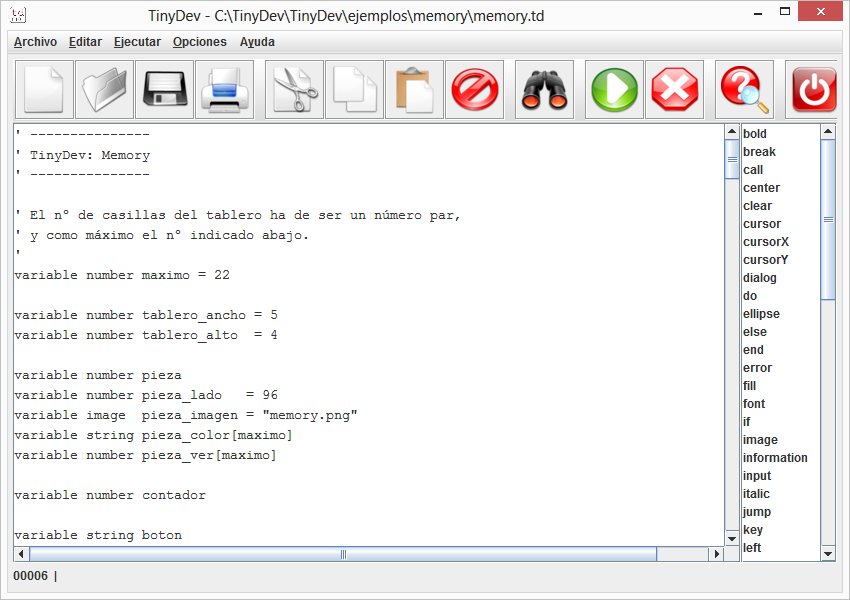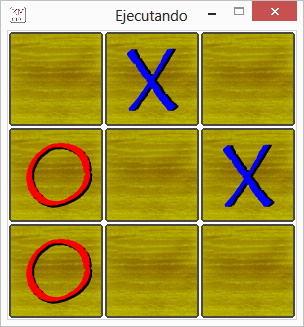CP/M CONNECTIONS
This is my blog dedicated to the world of the CP/M OS, the Z80 CPU, the AMSTRAD PCW computer and related subjects.
Tuesday, January 2, 2018
Thursday, March 23, 2017
TinyDev - Programming language for kids
I'm proud to announce TinyDev, my programming language for kids.
It was created with the goal they learn how to resolve logical problems.
Although it's a very complete language, it has been designed to be easy using it, avoiding the complications and difficulties of certain programming languages for kids, very much in vogue today.
Using TinyDev, the kids can draw graphics, write text, move images on screen, play sounds, and interact with their programs with the keyboard and the mouse.
In addition, it's accompanied by a small IDE (Integrated Development Environment). With it, the kids can create, edit and run their own programs, as with professional programming languages.
And... it's free!
The IDE of TinyDev has been designed to seem and act like the ones that come with the professional programming languages. Supports the English and Spanish languages.
It has the characteristic functions of this kind of environments, among them:
With the aim to help our little kids to learn this programming language, it has been developed some example programs, which show the capabilities of TinyDev.
Some of them are:
The requirements to install and run TinyDev are the following:
You can download TinyDev from their own website:
http://www.floppysoftware.es/tinydev/
Enjoy!
It was created with the goal they learn how to resolve logical problems.
Although it's a very complete language, it has been designed to be easy using it, avoiding the complications and difficulties of certain programming languages for kids, very much in vogue today.
Using TinyDev, the kids can draw graphics, write text, move images on screen, play sounds, and interact with their programs with the keyboard and the mouse.
In addition, it's accompanied by a small IDE (Integrated Development Environment). With it, the kids can create, edit and run their own programs, as with professional programming languages.
And... it's free!
The IDE of TinyDev has been designed to seem and act like the ones that come with the professional programming languages. Supports the English and Spanish languages.
It has the characteristic functions of this kind of environments, among them:
- Create, open, save and print source code files.
- Edit source code of programs.
- Run and stop the current program.
- Configure the IDE.
- Show help about the IDE and the programming language.
- Fast access buttons to the most frequent actions.
- Fast selection panel with all the keywords of the language.
- Information panel about the current source code.
With the aim to help our little kids to learn this programming language, it has been developed some example programs, which show the capabilities of TinyDev.
Some of them are:
- Chase - a game in which two robots want to catch you.
- Space - the classic game of space ships and asteroids.
- Memory - a game with coloured tokens, to exercise our memory.
- Simulation of an aquarium.
- The classic game of tic-tac-toe.
- Drawings - truck, building, screen effects...
The requirements to install and run TinyDev are the following:
- Computer with Java 1.8 or higher.
- Want to learn and have fun.
You can download TinyDev from their own website:
http://www.floppysoftware.es/tinydev/
Enjoy!
Labels:
Java,
Kids,
Programming,
TinyDev
Wednesday, August 3, 2016
Released part of manuscript of Gary Kildall
The Computer History Museum has released part of the memoirs manuscript of Gary Kildall:
http://www.computerhistory.org/_static/atchm/in-his-own-words-gary-kildall/
http://www.computerhistory.org/_static/atchm/in-his-own-words-gary-kildall/
Wednesday, September 9, 2015
New FloppySoftware website
I'm proud to announce my new website, where are uploaded all my software projects:
www.floppysoftware.es
The old url is not valid now, please, update your links.
Thanks, and sorry if any inconvenience.
www.floppysoftware.es
The old url is not valid now, please, update your links.
Thanks, and sorry if any inconvenience.
Friday, September 4, 2015
New release of MESCC: v1.08 - 04 Sep 2015
It's available a new release of MESCC: v1.08 - 04 Sep 2015.
It has only a small change, that will enable (optionally) the support for directory names, under CP/M.
See the library cpm.h for more details.
It has only a small change, that will enable (optionally) the support for directory names, under CP/M.
See the library cpm.h for more details.
Labels:
C Programming,
MESCC,
Small C,
Z80
SamaruX and directory names
SamaruX has now support for directory names.
With the use of the new built-in command diralias, you can reference a directory (a drive and user specification) with a name.
I.E.:
diralias root a0:
diralias temp m0:
diralias mescc a3:
cat mescc:sx.c | more
ls root:*.x
cd root:
It's a good idea to include the diralias commands in you SamaruX profile.
With the use of the new built-in command diralias, you can reference a directory (a drive and user specification) with a name.
I.E.:
diralias root a0:
diralias temp m0:
diralias mescc a3:
cat mescc:sx.c | more
ls root:*.x
cd root:
It's a good idea to include the diralias commands in you SamaruX profile.
Sunday, August 30, 2015
XPCW - graphics for the Amstrad PCW
XPCW is a graphics and keyboard library for the Amstrad PCW, under the CP/M operating system.
It consists of a CP/M Plus RSX file, with some library files (.h) for MESCC, my own version of the Small-C compiler.
The RSX is written in Z80 assembler source code.
It can be accessed by any CP/M program or language, provided it follows its conventions (read the RSX source code for more information).
The XPCW.RSX file, has to be attached to any program that uses this library.
Only one MESCC library is needed (xpcw.h), the other are optional.
The libraries are:
•xpcw.h - Main library.
•xdraw.h - Functions to draw pixels, lines, etc.
•xtext.h - Functions to write text, set the font, change attributes, etc.
•xchrdef.h - Functions to get / set character definitions.
•xbitmap.h - Functions to draw bitmaps.
•xkeyb.h - Functions to access the keyboard.
You can download XPCW in binary and source code form, from my website (includes Squarex, a little game).
It consists of a CP/M Plus RSX file, with some library files (.h) for MESCC, my own version of the Small-C compiler.
The RSX is written in Z80 assembler source code.
It can be accessed by any CP/M program or language, provided it follows its conventions (read the RSX source code for more information).
The XPCW.RSX file, has to be attached to any program that uses this library.
Only one MESCC library is needed (xpcw.h), the other are optional.
The libraries are:
•xpcw.h - Main library.
•xdraw.h - Functions to draw pixels, lines, etc.
•xtext.h - Functions to write text, set the font, change attributes, etc.
•xchrdef.h - Functions to get / set character definitions.
•xbitmap.h - Functions to draw bitmaps.
•xkeyb.h - Functions to access the keyboard.
You can download XPCW in binary and source code form, from my website (includes Squarex, a little game).
Labels:
Amstrad PCW,
C Programming,
MESCC,
XPCW
Subscribe to:
Posts (Atom)


